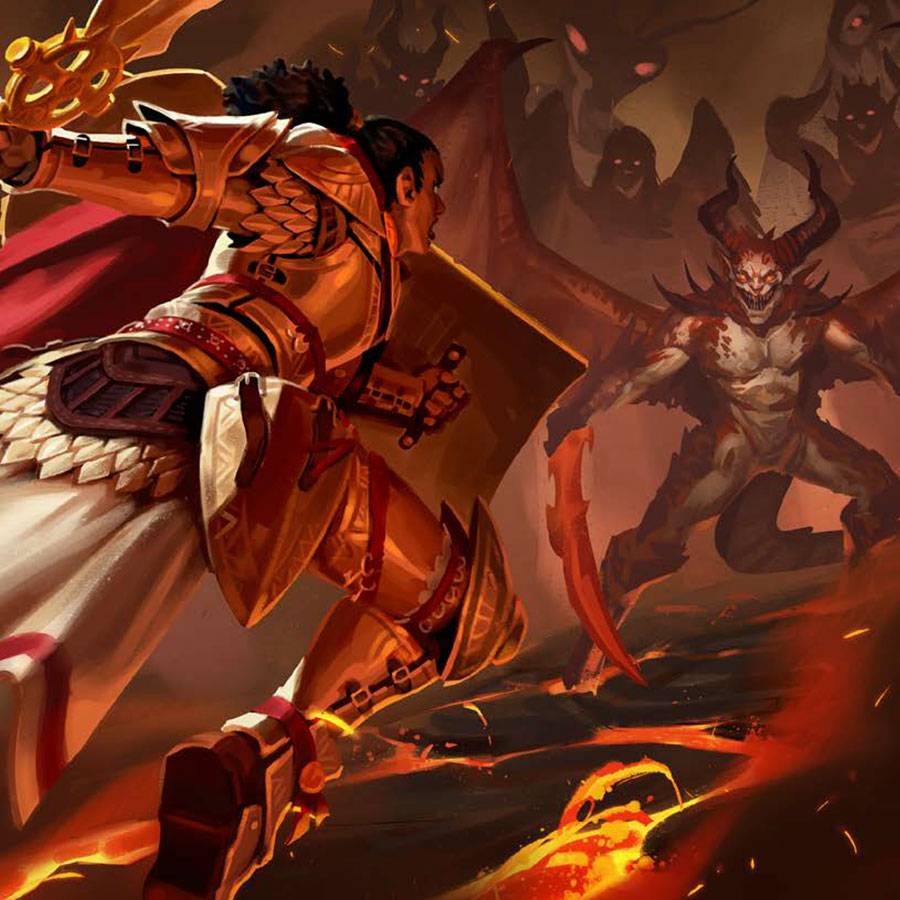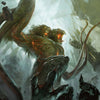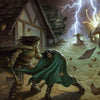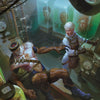D&D Campaign Pacing | How to Pace Your Game Sessions

If you’re a game master, creating proper pacing in your tabletop roleplaying game (D&D, Pathfinder 2e, etc.) is of critical importance. Good pacing is the thing that takes a so-so game and turns it into a great game.
So, in this article we’ll discuss what pacing is in a TTRPG, the use of time to regulate pacing, using campaign pillars to improve pacing, and things to avoid that can destroy pacing.
By the way, if you play D&D 5e or Pathfinder 2 online and are a bit frustrated with having to set up maps, tokens, and lighting in your VTT, you should check out our premium Foundry VTT modules. Get professionally developed 5e and PF2e adventures and monsters for your games…and we do most of the work for you. All you need to do is install the module and start playing!
Watch or listen to this article by clicking the video below.
What Is Pacing?
Before we can discuss how to create good pacing, we should probably define it, and to define it, we need to ask ourselves what the foundation of all tabletop RPGs is. And the answer to that is meaningful choices.
The sentence I repeat the most at all my games is perhaps, “What would you like to do?” And then my players tell me, I adjudicate, and then we repeat. Our games are essentially a string of me asking my players what they want to do, them telling me, and then me resolving what happens, often based on dice rolls.
However, the choices must be meaningful. If they are traveling down a road and heading to a dungeon and I say, “Okay, you’ve traveled 5 minutes. What would you like to do?” My players are going to say that they keep going down the road. Now, if I ask them after every 5 minutes of in-game travel what they want to do, it gets silly and pointless. Why? Because there is no MEANINGFUL CHOICE.
Contrast that with this: “You travel down the road for a couple hours and then hear a scream off in the distance. It sounds like it’s coming from the treeline. What do you do?” Now see, THAT is a meaningful choice because something is clearly afoot. My players may fall for my very obvious side-quest plot hook, or they may decide to keep traveling. The choice is theirs, and the decision they make is important and will influence future events.
So, an RPG must consist of meaningful choices, and if you’ve ever been in a game that seemed SLOW or BORING, chances are good that there weren’t enough meaningful choices. Which means that there was too much dead space, or time, between those choices.
And now we’re starting to get at the heart of PACING: removing as much of that dead space between meaningful choices as possible.
This is one reason that locations-based adventures—usually simply referred to as “dungeons” even though they can take place anywhere—are such an effective tool in tabletop RPGs: almost every choice in a dungeon is meaningful. Opening the door, checking the chest for traps, inspecting the fireplace, brokering a truce with the goblins…or deciding to attack. Gameplay in a dungeon is packed with meaningful choices.
I mean, there is a reason that 90% of my games take place in dungeons. LOL
Removing the Dead Space
Okay, so we know we want to remove the dead space between meaningful choices, but how do we do that?
First, let’s mention that a “scene” is the game mechanic by which meaningful choices are typically delivered. For instance, above I set the scene of the party traveling to a dungeon but then hearing a scream from the treeline.
To remove the dead space, you essentially just skip from scene to scene. Okay, they heard a screen from the treeline—that was the meaningful choice—and the players decided to go investigate. So, I say, “You walk over to the treeline—give me Perception checks—and notice three figures dragging off a man and a woman. What do you do?” And that right there is the next scene that delivers the next meaningful choice.
What we’re doing as well when removing dead space is threefold: First, you identify the intention of the players (travel to the dungeon). Second, you determine the obstacles they may encounter and present a meaningful choice (a scream from the treeline). Then you rinse and repeat.
This may seem brain-numbingly simple…and it kind of is. The trick is to not lollygag and not burden your game with unnecessary fluff that is of little interest to the players and has nothing to do with resolving the current scene or getting them to the next one. And in this context, each scene MUST have a meaningful choice.
Here is a classic example of bad pacing and a horrible scene. I was once a player in the group and we were traveling somewhere. Well, the game master had us spend about 30 minutes working out and roleplaying how we were going to cross a river. Well, there was a druid who could shapechange into a turtle, so getting across was trivial. But we had to play out ROUND BY ROUND who went across the river first, who was left on the one bank, who was on the other, etc. And for what? Did we get attacked while split up on different sides of the river? Nope, nothing. We just had to roleplay crossing the river.
So what was the problem with that scene, you may ask? THERE WAS NO MEANINGFUL CHOICE. How we decided to go across the river had ZERO impact on the results of the game. It was a pointless waste of game time.
On Using Time for Pacing
In essence, the concept of pacing is based on how you use TIME in a campaign. There are a few different kinds of time in tabletop RPGs that help you, the game master, control pacing at your table.
Now Time. This is "being in the moment." This is when real-time is progressing at the same pace as in-game time. Most of a game session is usually played this way.
Slow Time. Everything slows down when something important or meaningful is happening, such as when a player has to make an important decision or a meaningful combat is taking place. The narration of events in slow time take longer to resolve in real-time than it takes for the characters to experience it. Combats are a good example of this.
Abstract or Fast Time. This sort of time applies when things that aren't super important are happening and the game master can resolve them with some narration or the players can quickly get it done faster in real-time than it would take in game time. Shopping for supplies is an example of this.
Sharp Cut. This time and pacing technique is used when things are meaningless overall, such as walking down an empty hallway or traveling across a safe town to go to the general store and get supplies. With sharp cuts, the GM quickly narrates the party to the next scene where a meaningful choice is made. Large gaps of time may be skipped very quickly.
As I said, these forms of time allow you to control pacing in your games, and generally speaking, this is when you use them.
- When you are seeking to remove dead space, you’ll use Abstract Time or Sharp Cuts.
- When the characters are interacting with the majority of their scenes, you’ll use Now Time.
- When the characters are interacting with a scene that is super important and filled with meaningful choices, you’ll use Slow Time.
On Player Preferences
But there is more to good pacing than focusing on cutting out the dead space between meaningful choices. You also want to consider player preferences.
Adventure pacing is highly dependent on the types of players that you have. Campaign Pacing is even more dependent on that. Players want their choices to feel meaningful, and when a scene or encounter focuses on something they care about, it becomes meaningful.
Understanding your players is THE biggest key to campaign pacing. In 1996, Game Researcher Richard Bartle divided players into four types based on their primary motivation:
- Player-focused, prefers to act
- World focused, prefers to act
- Player-focused, prefers to interact
- World focused, prefers to interact
The "Bartle Test" determines where a player falls within these categories, and can help a GM design and pace their game based on "campaign pillars," which focus the scenes, encounters, and adventures around what players enjoy most.
However, whether or not you use that tool, the main point here is that you want to build your game around your players’ preferences. When you fill your scenes with meaningful choices that you know will appeal to your players, it makes the pacing all that much better because your players will CARE MORE about what is happening. And this in turn amps up their excitement and paces out the campaign to their satisfaction.
Make sure, of course, that your game consists of things that appeal to YOU, the game master, too. That is non-negotiable. No GM should be cursed with running a game they don’t enjoy.
Using Your Campaign Pillars
You may have heard of the three pillars of a roleplaying game—combat, exploration, and social interaction—but while those are relevant, that’s not exactly what we’re talking about here. Instead, what you want to do is establish special “campaign pillars” that you will build your campaign, adventures, and encounters around. For instance, let’s say you know that your players love challenging tactical combat, traps, political maneuverings, and interacting with new and interesting NPCs.
With that information, you would seek to do the following:
- Try to include at least one or two of your pillars in each game session.
- When you use a pillar, especially if it's something that all of your players enjoy, bring down the pace of play to focus on it and make it memorable—this is Slow Time. Don’t be a stickler on making sure everything moves in real-time. Allow game time to slow down so players can savor the moment.
- Build that encounter up; intensify it with a twist, major threat, or something meaningful to a player's backstory.
- Pillars need to have a reason for happening. They need to be intentional and have meaning to one or more players.
- Don't focus as heavily on non-pillar moments. Things that players don't care as much about during the game create dead space. For example, your players probably don't care about how they get to the new NPC... So, don't describe every street, turn, and carriage along the way. Burn through the negative space and get to the stuff your players really care about. These are the moments to speed up game time and narrate such that time is skipped—this is when you want to use Abstract Time or a Sharp Cut.
- When you're prepping the game, focus on the pillars... not on the dead space.
Other Things That Help Pacing
The number three is a key number in making something memorable to a person. It's baked into human psychology. Repeating something three times makes it memorable.
When describing a scene, use at least three of the five senses. When describing a location, focus on three important things that the players can see or interact with. Include minor scene dressing to "fill the frame", but there should only be THREE focal points.
Keeping the game moving. Social Interaction between players is fine and great unless the rest of the table is getting restless. "Planning Sessions" need to have a time limit, otherwise they'll turn into analysis paralysis and bring the game to a screeching halt. "Shopping Sessions" are fun for very few players, so it's important to make sure they don't bog anything down.
Enable the players to help create and maintain the pace. Proactive players can generate momentum. Don't inhibit that because of what you have planned. Ask your players if there is some personal quest or objective they'd like to pursue in the current and future sessions.
Poll the players from time to time to get their input on how things are going.
Things to Avoid
Interruptions and Obstacles to the game. These are pacing killers. It's okay to take breaks, but those breaks should come before or after Pillar Scenes, never in the middle of one.
Trying to force it. The GM should plan for pacing, but just like anything, trying to railroad players into the moment isn't going to help.
Skipping something that is meaningful or important to one of your players just because it isn't important to you as the GM. This is where knowing your players really matters.
We Make Playing Online with Foundry VTT Easier Than Ever
Look, running a 5e or Pathfinder 2e game can be challenging, and you’re probably busy enough with adult responsibilities as it is. Why not let the DM Lair team do some of the work for you?
With our professionally developed Foundry VTT modules, you’ll get expertly designed adventures and monsters with the following features:
- Scenes pre-configured with walls, lights, and high-res tokens
- Highly detailed immersive adventure maps
- Journal entries for the entire contents of adventures
- Read-a-loud text, interactive monster stat blocks, roleplaying notes, encounter notes, and more
Don’t spend another moment scrambling to put together an adventure and set everything up in Foundry before your next 5e or PF2e game session! Let DM Lair Foundry modules remove the frustration from GMing.
-
Posted in
Game Master How-To Articles







